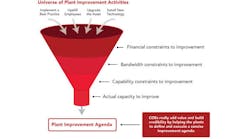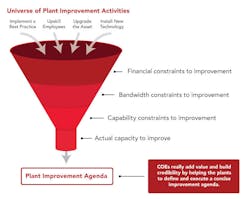Over the course of my career in operational excellence I’ve partnered with a number of companies that have applied a “centers of excellence” (COE) model in support of their continuous improvement program.
I’ve observed COEs that were very well resourced with multiple dedicated full-time functional or subject matter experts and others that were cobbled together through a combination of plant and leveraged resources tasked with doing the work of the COE in addition to their day-to-day jobs.
I’ve also seen a variety of COE constructs, from functional to practices/tools-based to those that mirror the production process and everything in-between.
Long story made short, when it comes to COEs, there does not appear to be a standard model, and although I have personal preferences, the reality is that different models can be effective.
That being said, even though the model tends to be variable across companies, the work of the COE tends to be quite similar, including (but not limited to):
- Defining a common set of best practices and work standards
- Assessing (or helping others to assess) the maturity profile of the plants against these best practices and work standards
- Providing direct (i.e., in-person) and/or indirect (e.g., instructional content, tools & templates, etc.) guidance and support to assist plants in implementing these best practices work standards
It’s hard to argue that the work described above isn’t important. It seems clear to me that if the organization is serious about driving a consistent approach to plant operations management, then it needs to establish and document a common set of practices and standards.
Furthermore, if the organization does not define a governance process for these practices and standards or provide support in implementing them, then why should it expect that they will be followed?
So the critical issue for me when it comes to COEs isn’t whether the work they’re doing is important to the business. Instead, the critical issue is how to ensure that their effort isn’t wasted, and unfortunately, all too often that is the case.
Lots of well-intentioned, hard-working people spend a ton of hours compiling best practices, developing content and performing assessments only to see a distinct lack of real impact at the unit of implementation, the plant.
This phenomenon needs to change…the remainder of the article provides two recommendations for how to best leverage the COE model in support of business results.
Recommendation 1: Less is More
Without question the No.1 objection I hear from plant leaders is that the support they receive from the COEs does not take into account the reality of life in the plant. The complaint usually sounds something like this (only slightly exaggerated for effect):
“Every time those experts from corporate come to this plant to do one of their assessments, they leave us with a list of 100 things that we need to be doing differently based on spending a total of three days at the site. They talk constantly about the need to be world class as if we can snap our fingers and all of the fires we’re fighting here will suddenly disappear.”
Now there’s a lot to dissect in the comment above, including the obvious signs of an “us vs. them” mentality and the lack of awareness as to the importance of comparing performance against a world class standard, but embedded in that comment is a call for help that the organization needs to answer.
Here it is…in general plants don’t need someone to give them a complete account of everything they’re doing wrong, thereby adding to their already long improvement wish list. Rather, what they need is someone to help them identify and execute against the short list of improvements that will really drive value.
Picture a funnel like the one below. At the top of the funnel is the universe of activities that the plant could undertake to improve the operation. The bottom of the funnel represents the actual (not perceived) capacity of the plant to drive improvement after all financial, bandwidth and capability constraints are factored into the equation.
To be clear, this isn’t a criticism of thorough, “bottom up” opportunity assessments so much as a recommendation that those assessments lead to a concise, manageable list of very practical, actionable recommendations that will (a) help address an immediate operational need, (b) help the plant to make progress against one or more strategic objectives, and (c) incrementally improve the operational maturity of the plant in the process.
A quick side note on letter “c” above…improving the operational maturity of the plant should always be positioned as a means to an end, not an end to itself. If the organization is driving best practices without clearly articulating the performance benefits it expects to achieve, then it risks that the continuous improvement program develops a reputation as nothing more than an academic exercise.
Returning to the crux of the issue, if the COEs can get alignment with plant leadership on the critical few improvements that need to happen and focus on providing exactly the guidance and support the plant needs to make progress, no more and no less, then it will truly add value and build credibility at the same time.
Recommendation 2: One Integrated Approach to Rule Them All
A former production system program manager I know (also a former plant manager) once described his company’s centers of excellence as akin to charitable organizations, and if you think about it, the analogy makes some sense.
First, both COEs and charities are supported by a small, committed group of people who want to inform and educate a much larger population for the expressed purpose of making some sort of improvement. Second, both COEs and charities typically ask for something from that population -- charities want support for their cause in the form of money or time, and COEs want the plants to implement the recommended best practices and work standards.
And finally, in both cases there’s a limit as to how much of an investment people can make. Referring to charities, because no one has unlimited money or time, people are naturally very selective about which charitable organizations they support and, in the event that they discover that a charity is not making good use of their support, they will discontinue their association.
The same is true for COEs. We’ve already discussed the many constraints that the plants have to face in their improvement journey, which means that plant leaders are instinctively jealous of their employees’ time and often skeptical of any effort to impose an improvement agenda upon them. So if the COEs are not highly efficient and coordinated in how they engage with the plants, then plant leaders may seize upon that lack of efficiency and coordination as a reason to resist the process.
Here’s a representative scenario. Let’s pretend that ABC Company has 4 functionally-focused COEs -- Quality, Maintenance & Reliability, Safety & Environmental, and Energy. Each COE is resourced with functional experts who work independently to develop and deploy their assessments, practices, and standards.
At no point is there any substantive interaction among the COEs about how to best engage the plants. Each COE views its work as related but largely distinct from the other COEs. So here is the “glass half empty” view as to how that scenario likely affects each plant:
- The plant has to host four different assessments per year on top of all other required audits and customer visits
- The assessments aren’t aligned with the plant’s natural strategy-setting process, leaving plant leaders to figure out how to integrate any recommendations from the COEs into the overall improvement strategy
- Each assessment generates a “laundry list” of recommended improvements, all of which are positioned as high priority and extremely urgent (see tip 1 above), which makes prioritization near impossible
- Because there is some overlap in subject matter across the four COEs, the plant finds itself getting assessed against the same criteria more than once
- Because the COEs weren’t coordinated when they developed their practices and standards, some of their recommendations may actually conflict (e.g., The Energy COE recommends switching to variable frequency drives right away but the Maintenance & Reliability COE recommends waiting)
The scenario above illustrates the tremendous importance of taking a highly coordinated approach to how the COEs interact with the plants. I highly recommend that the COEs undertake a thorough process to align on common standards, integrate content, and engage the plants with one voice and one approach. Questions to answer include:
- Can we align on one streamlined assessment framework and process? If not, how do we minimize the burden on the plants without compromising our approach?
- How do we help the plants to make balanced tradeoffs within and across the various COE work flows so we aren’t competing against each other for their limited time and attention?
- How do we develop content that is highly consistent across the COEs in structure and detail?
By undertaking a thoughtful integration process, the COEs will be better positioned to engage the plants in a highly coordinated manner, which dramatically increases the likelihood that their work will enable substantial and sustainable change.
Roger Price is the CEO of Phase 5 Group, LLC. Formerly P5G’s Manufacturing Practice Leader and Senior Director for New Business, Roger is currently leading the effort to develop and commercialize new product-based solutions for current and future manufacturing clients. Roger has led client engagements for DuPont, Land O’ Lakes, NOVA Chemicals, SunCoke Energy, and AB Mauri Food Inc. among others. You can contact Roger directly at [email protected].





